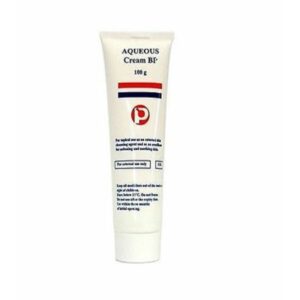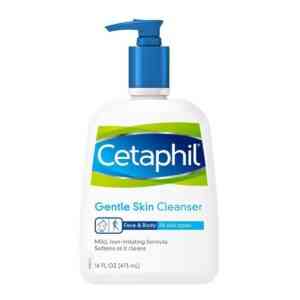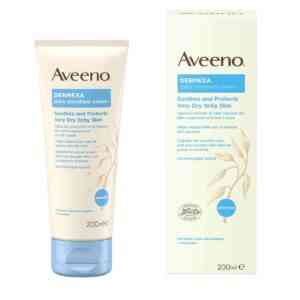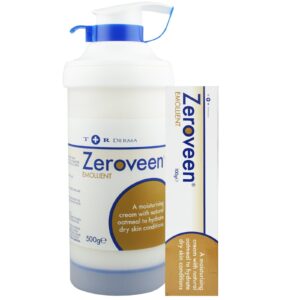Aqueous Cream, 500g
- For use as an emollient for softening & soothing skin.
- For topical use as an external skin cleansing instead of soap
- Softens & Moisturises Skin
- For use as an emollient for softening & soothing skin.
- For topical use as an external skin cleansing instead of soap
- Softens & Moisturises Skin
£3.50
CompareCompare- For use as an emollient for softening & soothing skin.
- For topical use as an external skin cleansing instead of soap
- Softens & Moisturises Skin
- Description
- Additional Information
- Brand
- How To Use
- Product Details
- Side Effects
- Ingredients
- Reviews (0)
- Questions & Answers
Aqueous Cream, 500g
Aqueous Cream has been formulated using a mixture of emulsifying ointment and water. This non-greasy moisturiser is ideal for the treatment of dry skin and is especially useful when suffering from eczema and dermatitis. Aqueous Cream helps to restore the skin to help it retain moisture and is suitable to use all over the body.
Aqueous Cream is an emollient used to relieve the symptoms of dry skin. It may also be used as a soap substitute for skin washing.
Aqueous Cream forms part of the Care range of tried and trusted remedies for everyday family ailments.
Aqueous Cream is used as a cleansing agent for your skin, and as an emollient to soothe and soften
Aqueous Cream used as a moisturiser to soften and sooth and rehydrate the skin, or as a cleanser instead of using soap to wash the skin
What Causes Dry Skin?
Dry skin isn’t usually serious. In most cases it’s caused by factors like hot or cold weather, low moisture in the air, and soaking in hot water.
You can do a lot on your own to improve your skin, including using moisturizers and avoiding harsh, drying soaps. But sometimes dry skin happens often or is severe. In these cases, you may need help from a doctor who specializes in skin (dermatologist)
Causes
Dry skin (xerosis) often has an environmental cause. Certain diseases also can significantly affect your skin. Potential causes of dry skin include:
- Weather. Skin tends to be driest in winter, when temperatures and humidity levels plummet. But the season may not matter as much if you live in desert regions.
- Heat. Central heating, wood-burning stoves, space heaters and fireplaces all reduce humidity and dry your skin.
- Hot baths and showers. Taking long, hot showers or baths can dry your skin. So can frequent swimming, particularly in heavily chlorinated pools.
- Harsh soaps and detergents. Many popular soaps, detergents and shampoos strip moisture from your skin as they are formulated to remove oil.
- Other skin conditions. People with skin conditions such as atopic dermatitis (eczema) or psoriasis are prone to dry skin.
Risk factors
Anyone can develop dry skin. But you may be more likely to develop the condition if you:
- Are in your 40s or older. The risk increases with age — more than 50 percent of older adults have dry skin.
- Live in dry, cold or low-humidity climates.
- Have a job that requires you to immerse your skin in water, such as nursing and hairstyling.
- Swim frequently in chlorinated pools.
Complications
Dry skin is usually harmless. But when it’s not cared for, dry skin may lead to:
- Atopic dermatitis (eczema). If you’re prone to develop this condition, excessive dryness can lead to activation of the disease, causing redness, cracking and inflammation.
- Infections. Dry skin may crack, allowing bacteria to enter, causing infections.
These complications are most likely to occur when your skin’s normal protective mechanisms are severely compromised. For example, severely dry skin can cause deep cracks or fissures, which can open and bleed, providing an avenue for invading bacteria
Symptoms
Dry skin is often temporary — you get it only in winter, for example — but it may be a lifelong condition. Signs and symptoms of dry skin depend on your age, your health, where you live, time spent outdoors and the cause of the problem. Dry skin is likely to cause one or more of the following:
- A feeling of skin tightness, especially after showering, bathing or swimming
- Skin that feels and looks rough
- Itching (pruritus)
- Slight to severe flaking, scaling or peeling
- Fine lines or cracks
- Gray, ashy skin
- Redness
- Deep cracks that may bleed
What is Eczema?
Atopic eczema (atopic dermatitis) is the most common form of eczema, a condition that causes the skin to become itchy, dry and cracked.
Atopic eczema is more common in children, often developing before their first birthday. But it may also develop for the first time in adults.
It’s usually a long-term (chronic) condition, although it can improve significantly, or even clear completely, in some children as they get older.
Atopic eczema causes the skin to become itchy, dry, cracked and sore.
Some people only have small patches of dry skin, but others may experience widespread inflamed skin all over the body.
Inflamed skin can become red on lighter skin, and darker brown, purple or grey on darker skin. This can also be more difficult to see on darker skin.
Although atopic eczema can affect any part of the body, it most often affects the hands, insides of the elbows, backs of the knees and the face and scalp in children.
People with atopic eczema usually have periods when symptoms are less noticeable, as well as periods when symptoms become more severe (flare-ups).
Eczema is the name for a group of skin conditions that cause dry, irritated skin.
Other types of eczema include:
- discoid eczema – a type of eczema that occurs in circular or oval patches on the skin
- contact dermatitis – a type of eczema that occurs when the body comes into contact with a particular substance
- varicose eczema – a type of eczema that most often affects the lower legs and is caused by problems with the flow of blood through the leg veins
- seborrhoeic eczema – a type of eczema where red, scaly patches develop on the sides of the nose, eyebrows, ears and scalp
- dyshidrotic eczema (pompholyx) – a type of eczema that causes tiny blisters to erupt across the palms of the hands
Aqueous Cream Reviews
After using Aqueous Cream, it’s helpful to let others know about your experience. Reviews of an item help other users know that medicines received have helped the condition it is claimed for, how well the treatment worked or any issues to be aware of. We invite our users to leave a review of both their treatment and of the service provided. Click on the reviews tab to see if there has been feedback on this item.
Price of Aqueous Cream in UK
Buy Aqueous Cream at Dock Pharmacy Essex UK, UK Online Pharmacy.
| Weight | 0.55 kg |
|---|---|
| Brand | |
Brand
Care
How To Use
How to use Aqueous Cream:
Apply to the affected areas of skin as required. The quantity required will depend on the skin condition. The product should be applied in the direction of hair growth.
Product Details
Before you use Aqueous Cream: Do not use if you are allergic to any of the ingredients. This product has been found to have major sunscreen activities and should not be used before any form of light treatment (phototherapy) or phototesting.
The product contains cetostearyl alcohol and sodium lauryl sulfate which may cause local skin reactions (e.g. stinging and contact dermatitis) particularly in children with eczema. Pregnancy:
The safety of Aqueous Cream during pregnancy and breast-feeding has not been established. Discuss with your doctor
Caution: This preparation may make skin and surfaces slippery particularly when having a bath or shower.
If you have any further questions on the use of this product, ask your pharmacist or doctor. If you accidentally swallow Aqueous Cream: contact your doctor or pharmacist.
WARNING: Do not smoke or go near naked flames – risk of severe burns. Fabric (clothing, bedding, dressings etc) that has been in
contact with this product burns more easily and is a serious fire hazard. Washing clothing and bedding may reduce product build-up but not totally remove it
Storing Aqueous Cream: Keep out of the sight and reach of children.
Store below 25˚C. Do not freeze.
Use within 3 months of the initial opening. Your pharmacist
will dispose of any unused cream.
Side Effects
Side effects: Like all medicines, this medicine can cause side effects although not everybody gets them.
Side effects to aqueous cream include occasional allergic reaction, acne, inflammation or infection of hair follicles (folliculitis), stinging, burning, itching, redness, contact dermatitis and rash
Ingredients
Aqueous Cream contains: Emulsifying Ointment 30% w/w (the ingredients of which are: cetostearyl alcohol, sodium lauryl sulfate, liquid paraffin and white soft paraffin), phenoxyethanol
and purified water
Only logged in customers who have purchased this product may leave a review.
Questions and answers of the customers
There are no questions yet, be the first to ask something for this product.
Other Products From This Seller
Original price was: £34.99.£24.95Current price is: £24.95.
Wahl Extreme Grip Beard Trimmer Precision Grooming with Comfort Grip and Adjustable Cutting Lengths Take Control of Your Grooming with the Wahl Extreme Grip Beard Trimmer Transform your grooming routine with the Wahl Extreme Grip Beard Trimmer, designed for precision, comfort, and versatility. Whether you’re sculpting a sharp beard line, maintaining stubble, or styling longer […]
Learn MoreOriginal price was: £34.99.£24.95Current price is: £24.95.
- Availability: in stock
Original price was: £23.99.£17.95Current price is: £17.95.
WAHL Vogue Corded Hair Clipper for Men Professional Precision with Adjustable Taper Lever and High-Carbon Steel Blades Transform Your Grooming Routine with the WAHL Vogue Corded Hair Clipper for Men Elevate your grooming experience with the WAHL Vogue Corded Hair Clipper, a professional-grade grooming tool designed for men who value precision and performance. Whether you’re […]
Learn MoreOriginal price was: £23.99.£17.95Current price is: £17.95.
- Availability: in stock
Original price was: £30.00.£8.95Current price is: £8.95.
Wahl Peaky Blinders Beard Trimmer Gift Set Limited Edition Cordless Grooming Kit for Men Join the ranks of the Peaky Blinders with the Wahl Peaky Blinders Beard Trimmer Gift Set. This exclusive collaboration between Wahl and the iconic TV series offers a comprehensive grooming solution for the modern gentleman. Key Features: Rechargeable Cordless Trimmer: Equipped […]
Learn MoreOriginal price was: £30.00.£8.95Current price is: £8.95.
- Availability: in stock
Original price was: £54.63.£39.95Current price is: £39.95.
OMRON RS2 Wrist Blood Pressure Monitor Compact and Accurate BP Monitoring The OMRON RS2 Wrist Blood Pressure Monitor is a compact and user-friendly device designed for quick and accurate blood pressure and pulse rate measurements. Utilizing the oscillometric method, it ensures reliable readings with minimal user input. Key Features: Automatic Inflation: The device inflates the […]
Learn MoreOriginal price was: £54.63.£39.95Current price is: £39.95.
- Availability: in stock
Original price was: £69.99.£59.99Current price is: £59.99.
Omron M4 Intelli IT Blood Pressure Monitor Bluetooth-Enabled Upper Arm BP Monitor with Intelli Wrap Cuff The Omron M4 Intelli IT Blood Pressure Monitor is a clinically validated device designed for easy and accurate blood pressure monitoring at home. With Bluetooth connectivity, it seamlessly syncs your readings to the Omron Connect app, allowing you to […]
Learn MoreOriginal price was: £69.99.£59.99Current price is: £59.99.
- Availability: in stock
Original price was: £39.99.£33.95Current price is: £33.95.
Omron M2+ Upper Arm Blood Pressure Monitor The Omron M2+ Upper Arm Blood Pressure Monitor is a fully automatic device designed to provide quick and accurate blood pressure and pulse rate measurements. Utilizing the oscillometric method, it ensures reliable readings with minimal user input. Key Features: IntelliSense Technology: Automatically inflates the cuff to the ideal […]
Learn MoreOriginal price was: £39.99.£33.95Current price is: £33.95.
- Availability: in stock
Original price was: £19.99.£9.95Current price is: £9.95.
Ted Baker M Gift Set 30ml EDT Spray and 150ml Body Wash Experience the refined elegance of the Ted Baker M Gift Set, comprising a 30ml Eau de Toilette Spray and a 150ml Body Wash. This meticulously crafted set offers a harmonious blend of notes, encapsulating masculinity and sophistication. Ideal for gifting or personal indulgence, […]
Learn MoreOriginal price was: £19.99.£9.95Current price is: £9.95.
- Availability: in stock
Original price was: £33.00.£19.99Current price is: £19.99.
Iceberg Twice Pour Homme Eau de Toilette 125ml Gift Set Aromatic Fougère Fragrance for Men Discover the timeless elegance of Iceberg Twice Pour Homme Eau de Toilette 125ml Gift Set, a sophisticated aromatic fougère fragrance designed for the modern man. This exclusive gift set includes a 125ml Eau de Toilette, offering a complete scent experience […]
Learn MoreOriginal price was: £33.00.£19.99Current price is: £19.99.
- Availability: in stock
Original price was: £44.00.£28.95Current price is: £28.95.
Davidoff Cool Water Gift Set For Men, 2pc Gift set Dive into the invigorating essence of the ocean with the Davidoff Cool Water Gift Set for Men. This exclusive 2-piece set includes a 4.2 fl. oz. Eau de Toilette and a 2.5 fl. oz. After Shave Balm, offering a complete grooming experience that embodies freshness […]
Learn MoreOriginal price was: £44.00.£28.95Current price is: £28.95.
- Availability: in stock
Original price was: £19.95.£9.95Current price is: £9.95.
Ted Baker W Pink Gift Set 30ml EDT and 150ml Shower Gel Experience the elegance of Ted Baker W Pink Gift Set, comprising a 30ml Eau de Toilette and a 150ml Shower Gel. This exquisite set offers a harmonious blend of floral and woody notes, encapsulating femininity and sophistication. Ideal for gifting or personal indulgence, […]
Learn MoreOriginal price was: £19.95.£9.95Current price is: £9.95.
- Availability: in stock

























Reviews
There are no reviews yet